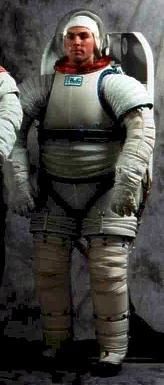
Home - Search - Browse - Alphabetic Index: 0- 1- 2- 3- 4- 5- 6- 7- 8- 9
A- B- C- D- E- F- G- H- I- J- K- L- M- N- O- P- Q- R- S- T- U- V- W- X- Y- Z
NASA Mark III
 NASA Mark III Suit Credit: NASA |
Status: tested 1992. Gross mass: 74 kg (163 lb).
The Mk III hybrid advanced suit assembly consisted of a hard upper torso, brief and hip transition elements, and rolling convolute shoulder, waist and hip abduction/adduction joints. It also offered upper arm, shoulder, hip, waist, and ankle bearings. The Mk III was intended to be pressurized at the relatively high pressurization of 0.56 atmospheres.
Although heavier than other suit designs, it offered superior mobility. By combining soft suit joints, hard joints, and bearings, all of the expected lunar or Martian surface mobility tasks could be performed within acceptable levels of effort. The task of kneeling and picking up an object could only be done by the Mk III in comparison with the Apollo A7L or Shuttle EMU suits. Handstands and somersaults could also be performed in the suit. Despite the success of the tests aboard a KC-135 on zero- and reduced-G flights, the NASA EVA Project Office at Johnson Space Center made the decision to pursue a soft suit design (the M-Suit) for future astronauts. The Mark III suit weighed 59 kg and its PLSS Portable Life Support System, 15 kg.
The MK III (H-1) space suit represented an 8.3psi technology demonstrator model of a zero-prebreathe suit. The basic torso shell, brief, and hip areas of the suit were composed of a graphite/epoxy composite lay-up. The lower arm and leg/boot areas of the suit were fabric. The suit contained a series of high-mobility joint assemblies in the shoulder, elbow, waist, hip, knee, and ankle areas. The MK III (H-1) suit incorporated either a 4-bearing joint system or a 2-bearing, rolling convolute joint arrangement that provided multi-axis motion. Single axis, all-fabric flat patterned joint systems were utilized for the elbow, knee, and ankle joints. Advantages of the fabric joint elements in the arm and leg areas of the suit included wearer comfort, less-cost, simpler construction features, and good mobility capabilities. A 3-bearing hip assembly and a single-axis rolling convolute waist joint coupled with a waist bearing provided excellent torso mobility. Sizing accommodations were provided by quick changeout sizing ring elements utilizing a wire cable attachment and interface method. Donning and doffing of the suit was achieved through a vertical rear-entry closure. Due to the structural nature of the torso shell, a portable life support system (i.e., backpack) could be directly mounted or integrated into the basic suit structure. In its 0.56 bar design configuration, the MK III (H-1)suit weighed 55 kg. However, since future planetary suits would be designed to operate at 0.26 bar, it was felt that the MK III (H-1) suit re-designed weight could be reduced to 36 kg with the incorporation of lightweight structural materials.
Family: Space Suits. Country: USA. Agency: NASA, NASA Houston. Bibliography: 489.
 | NASA Mark III Suit Credit: NASA |
 | NASA Mark III Suit Credit: NASA |
 | A7LB, Mark 3, M Suit Credit: NASA |
Back to top of page
Home - Search - Browse - Alphabetic Index: 0- 1- 2- 3- 4- 5- 6- 7- 8- 9
A- B- C- D- E- F- G- H- I- J- K- L- M- N- O- P- Q- R- S- T- U- V- W- X- Y- Z
© 1997-2019 Mark Wade - Contact
© / Conditions for Use